
Krzeczów
Elaboration author
Artur Karpacz
Monuments
Parishes
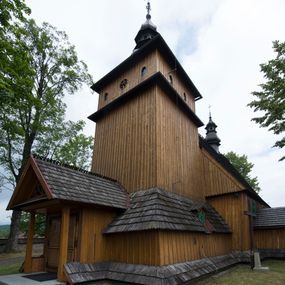
Saint Adalbert church in Krzeczów
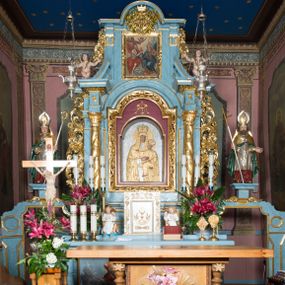
High altar
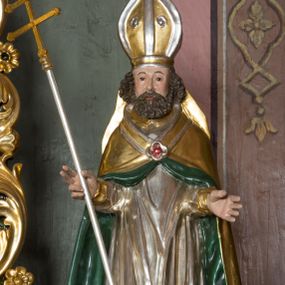
St. Adalbert
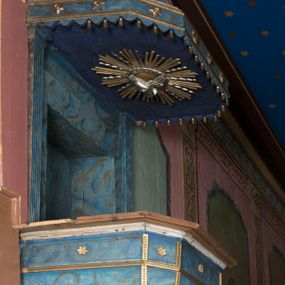
Pulpit
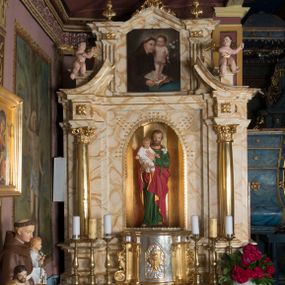
Left side altar
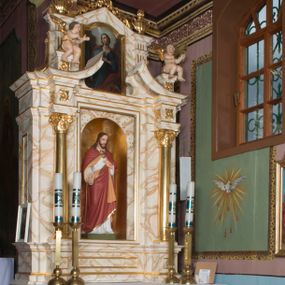
Right side altar
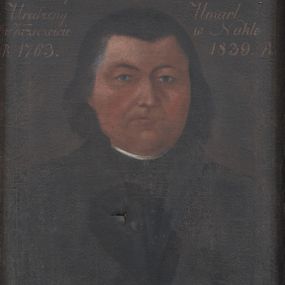
Picture
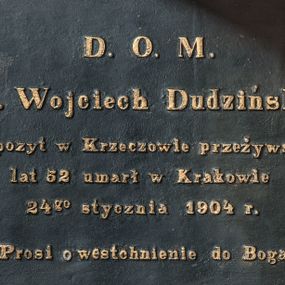
Epitaph plaque of father Wojciech Dudziński
History abstract
The beginnings of Krzeczów date back to the second half of the 14th century when the estates south of Myślenice were owned by the castellans of Cracow. The village was probably founded at the turn of the 14th and 15th centuries and the oldest source references to the settlement date back to 1425. The conscript register from 1581 states that the village consisted of 15 half-field farmers (about 150 ha), 3 landless tenants with cattle and 2 landless tenants without animals, as well as a craftsman and a vendor. A hundred years later, the village was inhabited by 15 peasants who cultivated 41 rods of land (over 60 ha) and 21 landless tenants. The intense development of the manor and serfdom economy led to disputes between castellans, village leaders and tenants and the peasants (the last riots in the demesne took place at the turn of 1749–1750). During the Bar Confederation, the village leader of Krzeczowa village, Sebiastian Chęciński, helped Colonel Kazimierz Pułaski's troops marching through the Raba valley towards eastern Lesser Poland. After the first partition of Poland, the estate of the former castellany was purchased by the duchess Francis of Krasińscy, the wife of duke Karl Christian Joseph of Saxony. In 1787, the estate was taken over by the daughter of Francis, Marie Christine de Carignan, who was remarried to duke Julius Maximilien de Montléart. According to the inventory from 1780, the village had 436 inhabitants, including 96 families. The turn of the 18th and 19th centuries left its mark on the region with numerous plagues called "grasanki" by the highlanders. However, the famine of 1847, resulting in increased susceptibility to typhus, dysentery and smallpox, was the greatest disaster in Western Galicia of the pre-industrial era. The previous year's slaughter in the "Myślenice state" was marked by several attacks by rebellious peasants on manors and parsonages. After 1867, the competences of rural self-governments changed and they became legislative bodies. The second half of the 19th century was also marked by the development of local co-operatives. Agricultural clubs and associations were established to provide knowledge about the latest cultivation techniques and fertiliser application. In 1874, the heiress of Augusta de Montleart declared to erect a new school building, financed then by the next owner of the estate, Cecilia Lubomirska. Galician rural areas were quickly overcrowded. The poor highlanders moved abroad for seasonal work in Hungary, Germany and France. At the turn of 20th century, the village had over 650 people and 132 hectares of land. The front of World War I bypassed Krzeczów. In the 1930s, the authorities of the Republic of Poland decided to modernise the Zakopane road and adapt it to the capabilities of modern cars. On 4th September 1939, Wehrmacht soldiers took over the surrounding areas, which began a five-year occupation. On behalf of the invaders, the villages were to be ruled by village leaders and the "dark blue" police. At the end of June 1943, the village was pacified. The Nazis started a roundup of people who were forced out of their homes and handed them over to a court-martial. In January 1945, fights took place in the valley of the Krzeczówka River, where German units were fortified. The post-war period was a time of huge uncertainty, anxiety and instability. Former political activists and partisans from the Home Army were arrested. After the administrative reform of 1954, the village was connected to electric grid from Lubno. As part of the national action to build a thousand schools for the millennium of the country's existence, a new seven-class educational institution was opened there in 1960. In the 1970s, the construction of a new fire station was commenced and development of gas network in Krzeczów was planned.
How to cite?
Artur Karpacz, "Krzeczów", [in:] "The Sacred Lesser Poland Heritage", 2026, source: https://sdm.upjp2.edu.pl/en/places/krzeczow-1